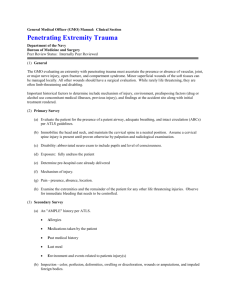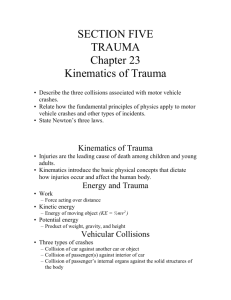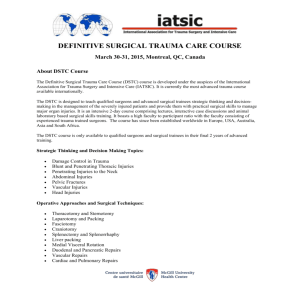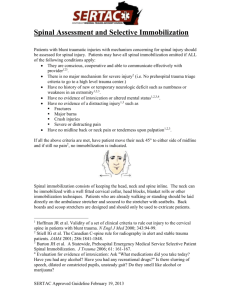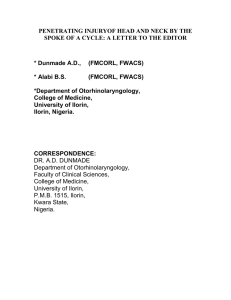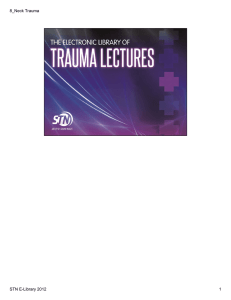Approach to Penetrating Neck Trauma
advertisement
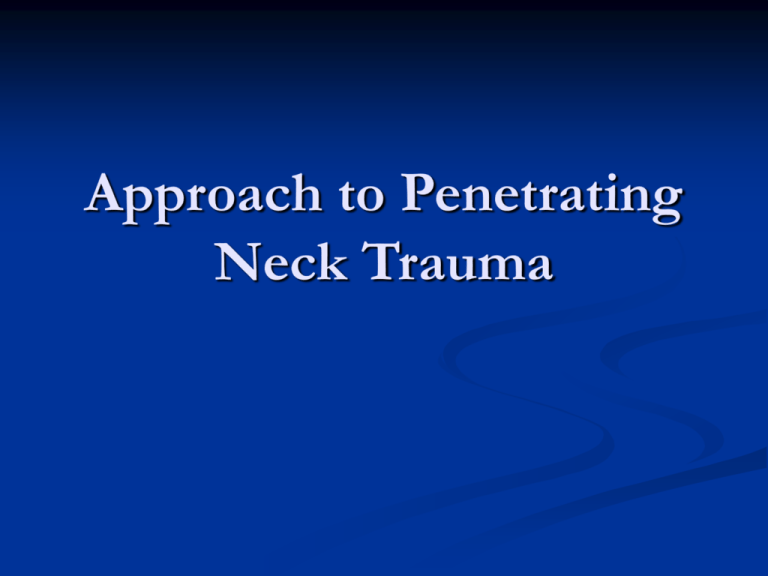
Approach to Penetrating Neck Trauma A case… BK, 49 yo male self-inflicted stab wound to neck Found by EMS with steak knife nearby Unknown time down Unknown head strike, unknown LOC. At scene patient was awake but non-communicative En route vitals stable A case…(cont.) PMH: unknown PSH: unknown Meds: unknown All: unknown Last meal: unknown A case…(cont.) On arrival… Vitals: T 98.0 BP 220/117 P 110 R 18 SaO2 100%RA Gen: Awake and talking but not following commands. No stridor or hoarseness in voice. HEENT: PERRLA, EOMI. Neck: 2 cm laceration Zone II along anterior boarder of right SCM. Minimal bleeding from wound and a non-expanding hematoma was present. CV: Tachycardia, reg rhythm Pulm: CTA B/L Abd: Soft, NT, ND. (+) BS. Rectal: Normal tone. No gross blood Ext: No gross deformities. Neuro: No focal deficits. Spontaneous movement all 4 extremities. A case…(cont.) CT head – negative CT neck – hematoma over R SCM. Trachea and esophagus intact. A case…(cont.) Taken to OR for wound exploration Findings: Underlying hematoma. Active bleeding from penetrating vessels of right SCM. No major vascular injury. No tracheal or esophageal injuries Penetrating Neck Trauma Management algorithm is not universal and is constantly evolving Recommendations range from surgical exploration of everyone (Roon et al, 1979) to selective observation (Meinke et al, 1979) Also depends on hospital’s availability of resources (ie. CTA/endoscopy) Penetrating Neck Trauma Two major types of injuries Major vascular injury Esophageal/bronchial injury Major Vascular Injury Strong suspicion: severe active hemorrhage, refractory shock, absent ipsilateral pulse, neuro deficit Weak suspicion: bruit, widened mediastinum, hematoma, diminished UE pulses, shock responsive to resuscitation Evaluation: surgical exploration, CTA or angiogram Aeorodigestive Tract Injury Signs/symptoms: hemoptysis, hoarseness, odynophagia, SQ emphysema, hematemesis Evaluation: Bronchoscopy Esophagoscopy or Gastrografin swallow Management Algorithms Management depends on level of injury: Zone I – Thoracic inlet to cricothyroid membrane. Zone II – Cricothyroid membrane to angle of mandible Zone III – Angle of mandible to base of skull Also depends on depth (superficial to platysma should be irrigated, debrided, closed primarily) Zone I Injuries Only 5% require operation CT angiogram or angiography widely advocated Min invasive techniques preferred for repair (embolization, endovascular stenting) Suspicion for aerobronchial injury? Bronchoscopy/esophagoscopy/Gastrografin swallow Zone III Injuries Surgery generally avoided due to difficult exposure CTA if clinical evidence of vascular injury Min invasive techniques preferred Bronch/esophagoscopy if evidence of aerodigestive injury Zone II Injury Highly controversial Wide spectrum of recommendations All agree that unstable patients or those with obvious vascular, tracheal or esophageal injury require surgical exploration What about the stable patients? Zone II Injury Surgical exploration for everyone? Pros: Easy exposure of vital structures Low morbidity/mortality of procedure Discovery of subclinical injuries Better hemostasis Cons: Cost (1981: estimated cost of exploration $1,930) High percentage of negative explorations (50-68% in most series) Zone II Vascular Injury CTA, duplex U/S and angiography have all been advocated CT can help define trajectory of penetrating object (proximity to vital structures) Zone II Esophageal/Bronchial Injury Bronchoscopy/esophagoscopy/Gastrografin swallow (same as I and III) Zone II Recommendations Mandatory exploration and selective observation are both acceptable strategies Large academic centers more likely to have resources to evaluate and monitor patients 24 hours/day Operative Approach Exposure: Incision along anterior boarder of SCM (most common) Arterial injuries: primary repair (preferred) vs. prosthetic grafts Venous injuries: ligate Tracheal/esophageal injuries: primary repair. Place drain to avoid mediastinitis from enteric content leak If both are injured a muscle flap placed between injuries can prevent TE fistula formation References Ayuyao AM, Kaledzi YL, Parsa MH, Freeman HP. Penetrating neck wounds. Mandatory versus selective exploration. Annals of Surgery. 1985;202:563-567. Demetriades D, Theodorou D, Cornwell E, 3rd, et al. Penetrating injuries of the neck in patients in stable condition. Physical examination, angiography, or color flow doppler imaging. Archives of Surgery. 1995;130:971-975. Jurkovich GJ, Zingarelli W, Wallace J, Curreri PW. Penetrating neck trauma: Diagnostic studies in the asymptomatic patient. Journal of Trauma-Injury Infection & Critical Care. 1985;25:819-822. Klingensmith ME, Chen LE, glasgow SC, et al. The Washington Manual of Surgery, 5th ed. Lippincott Williams & Wilkins. 2008; 375-377 Nemzek WR, Hecht ST, Donald PJ, et al. Prediction of major vascular injury in patients with gunshot wounds to the neck. Ajnr: American Journal of Neuroradiology. 1996;17:161-167. Roon AJ, Christensen N. Evaluation and treatment of penetrating cervical injuries. Journal of Trauma-Injury Infection & Critical Care. 1979;19:391-397. Saletta JD, Lowe RJ, Lim LT, et al. Penetrating trauma of the neck. Journal of Trauma- Injury Infection & Critical Care. 1976;16:579-587. Thomas AN, Goodman PC, Roon AJ. Role of angiography in cervicothoracic trauma. Journal of Thoracic & Cardiovascular Surgery. 1978;76:633-638. Tisherman SA, Bokhari F, Collier B, et al. Clinical Practice Guidelines: Penetrating Neck Trauma. Eastern Association for the Surgery of Trauma. 2008
